This post contains affiliate links. We may get paid an affiliate commission if you buy something or take an action after clicking one of the links on this web page.
Traditional knives are like genre fiction: they’re expected to follow certain tropes. These conventions are more restrictive than those we impose when we say things like ‘tactical knife’ or ‘EDC knife,’ maybe because they’ve been cultivated over a longer period of time. However, as with a fantasy or horror novel, it’s possible for a traditional knife to transcend its label and achieve greatness, whether it’s working outside of its associated tropes or within them. When a traditional becomes great outside its tropes you get things like the Spyderco Roadie. When it achieves greatness within them, you get Great Eastern Cutlery.
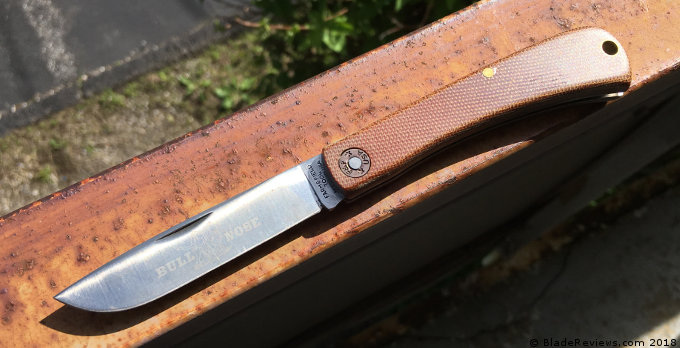
Buy the GEC Bullnose at BHQ Buy the Bullnose at KniveShipFree
GEC makes traditional knives, not as they actually were back in the day, but as we fondly remember them to be (or are told to remember them). Operating out of historic Titusville, PA, GEC turns out batches of knives ritualistically grabbed up by collectors and enthusiasts eager to own these tangible remembrances of a perceived better time.
But GEC doesn’t just peddle nostalgia porn. They make truly great knives, with fantastic fit and finish, in a variety of materials both man-made and (sadly) natural. And among patterns both original and obscure, GEC also puts out classic styles, often with some slight tweaks to them. Such is the #71 Bullnose, which is GEC’s gentle revision of the Sodbuster pattern.
I picked up a Bullnose in 2017. GEC produces their knives in batches, and the latest run of Bullnoses has hit the market. Should you buy one?
General Dimensions and Blade Details
GEC’s Bullnose has a blade length of 3.1 inches, a handle length of 3.8 inches, and a weight of 2.4 oz. It is made in the United States.
This take on Sodbuster doesn’t exactly reinvent the wheel, but you get a few little perks not seen on most Sodbusters: a wider butt end, and a big lanyard hole. The Bullnose hovers pleasantly in that arena of decent-sized knives that still maintain high pocketability. It can tackle most any cutting chore and yet drops into a pocket without a second thought.
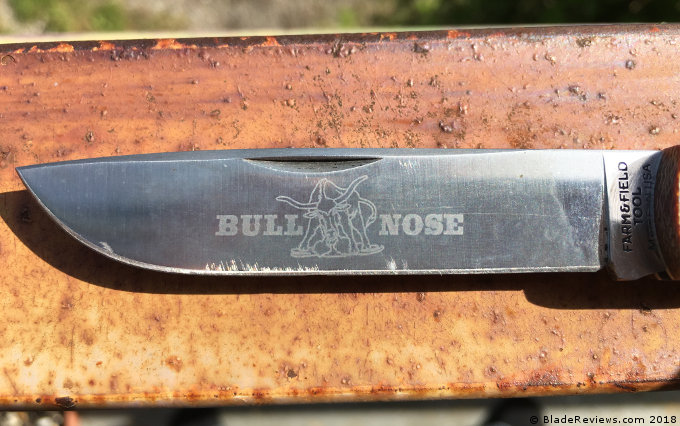
Superlative fit and finish is a hallmark of a GEC knife. These are lovingly crafted knives, pleasures simply to hold. I’ve had some very nice GECs including two different Tom’s Choice Barlows, and they’ve all been beautifully finished, but my Bullnose is the nicest of the lot. The layers are airtight, the corners chamfered, the blade centered. The swedges are somewhat uneven, but I haven’t seen any outfit get something like that consistently perfect. Basically it’s all good, no matter which way you turn it or where you look.
Presumably we get the name ‘Bullnose’ from the blade shape: a drop point, but with a squat front end, squashed in like the face of a pug. I suppose the idea is to add some meat to the tip without compromising piercing power, and it mostly succeeds in that. The Bullnose isn’t exactly a needle point but it punches through material easy enough. Another effect of the blade shape is to reduce the belly to a compressed section just below the tip, meaning that most of the working edge is a straight line. Not a bad thing, and when I needed the extra cutting muscle of a belly I angled the knife so that portion was pushing down into the material and went to town.
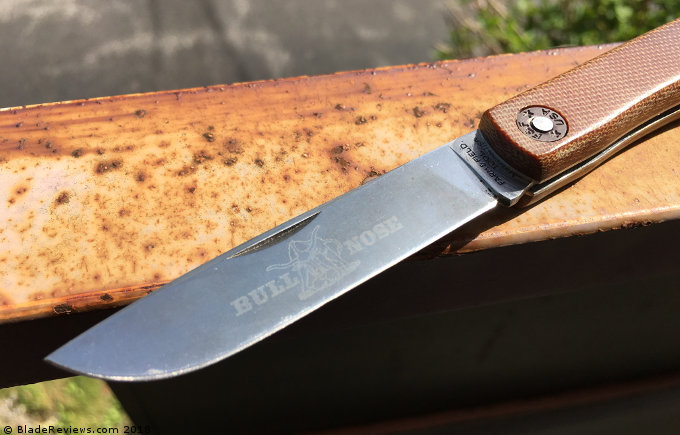
1095 steel is one of the traditional knife tropes. It’s a carbon steel, so you have rust to worry about – but you know that going in so I’m not going to fault it for that. Once you get a patina forming, the blade turns a smoky, cloudy gray and receives a noticeable boost in corrosion resistance. It holds an edge well if you’re cutting softish things like thread or food, but on rougher media like cardboard, edge retention isn’t going to be phenomenal.
Simply put, 1095 is mediocre. Not bad, but not great – not even merely good. GEC used to implement 440C on some of their blades and I would like to see that on the Bullnose, at least as an option for those who want it. If the Bullnose is sincerely meant as a working knife, I think the rust resistance and boosted edge retention would be worthwhile.
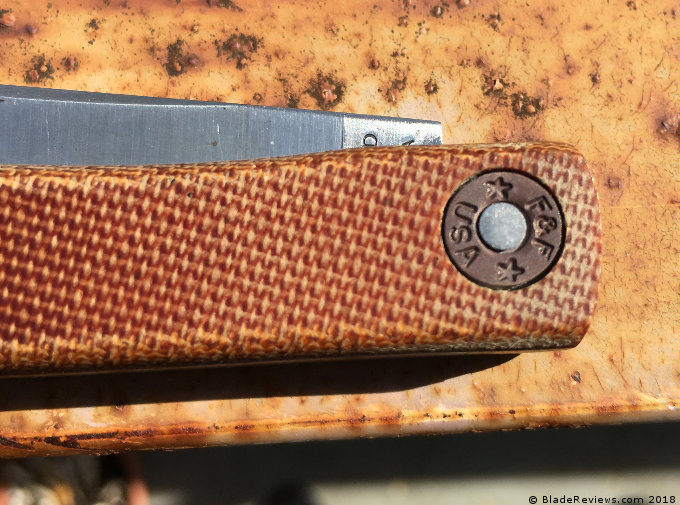
On a side note: I think I’m alone in this, but this is my fourth GEC and I’ve always found their 1095 exceptionally difficult to sharpen. Like, harder to get sharp than VG-10. From what I understand they run the steel a little harder than normal, and maybe this, combined with the thin edge geometry on these traditional blades, stymies my sharpening skills. But it’s definitely another black mark against the steel choice.
A Brief Digression into Warranty Stuff
You may be able to tell from my pictures, but there’s a nick in the blade of my Bullnose. Turns out that the blade was smacking against a portion of the backspring in the channel, where it rises to accommodate the pin that keeps it in place. Basically, it folded over a bit of the cutting edge.
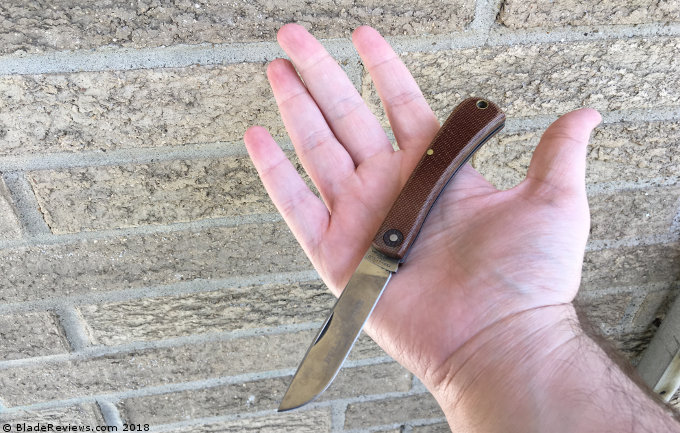
Once I figured this out, I sent the Bullnose to GEC, and they called me when they received it with a diagnosis. They said they could fix it, but because they don’t have a dedicated warranty department the turnaround wasn’t going to be lightning quick. A few weeks later, I got it back, and it seems like they fixed it, seemingly by sharpening the blade itself down a bit – not an elegant solution. The fold wasn’t completely sharpened out, just enough to stop it from happening anymore.
All of this isn’t to hate on GEC’s warranty work. Given the nature of how they operate, the full fat warranty departments of the big production companies isn’t feasible. But just be warned that if you have an issue, the resolution of that issue is going to be a little more homespun than what you’d get with LifeSharp, for example.
Handle, Ergonomics, and Carry
The Bullnose’s handle starts with a sizable butt end that tapers into a narrow, square neck. The finger side of the handle describes a gentle arc from tail to tip, with a flattened region just below the pivot where your index finger goes in a natural grip.
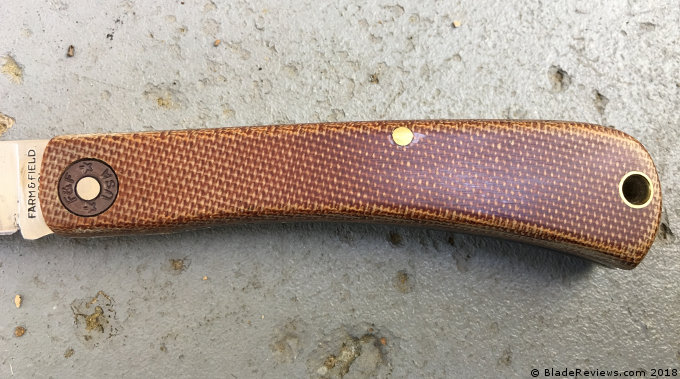
That’s a lot of words to describe what, in practice, is about as simple a handle as you can get – and the simplicity works. I was worried the beak would bite into my largish hands, but there’s enough room so that it keeps my hand in place without digging into it.
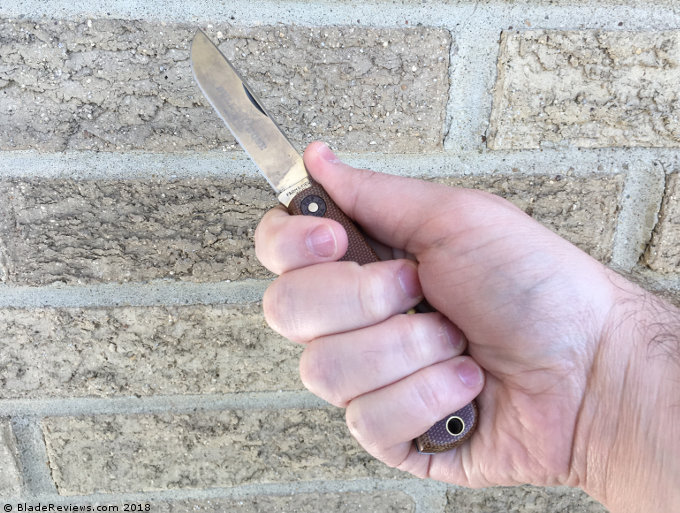
GEC releases its models in a gaggle of different handle materials, so the ‘grippiness’ of your particular choice may vary from my own. I chose the natural canvas Micarta which, despite its burlapy appearance, is pretty smooth – there’s just a hint of traction, more than enough for my uses, but you can probably find grippier options in the lineup. Something that may not be clear in pictures is that the Bullnose is a thick knife: the handle is half an inch wide. Wideness doesn’t always equate to comfort, but in this case it does. All work knives should be comfortable and the Bullnose handily makes the grade.
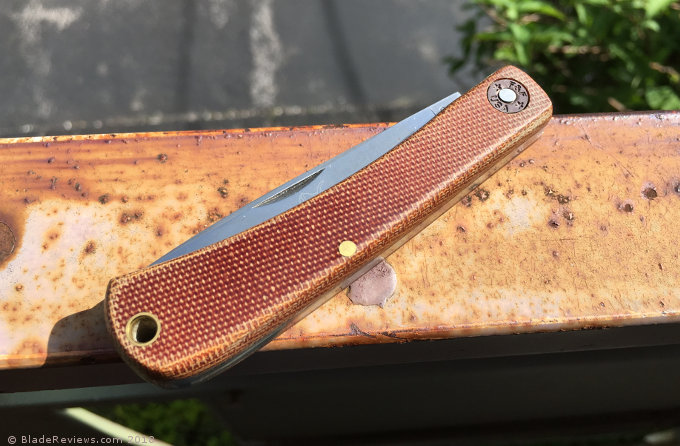
I lavished many words on the Bullnose’s simple handle, so I’ll be more concise in describing how it carries: perfectly well. Drop it in your pocket of choice and forget about it.
Deployment and Lockup
We’re back into trope land here – nail mark, two-hand deployment; you know the drill. I don’t really get nail marks. And I don’t mean that I find them outdated. For me, they just don’t work well. Is there any knife where sliding your stubby, frangible nail into a shallow divot is easier than just pinching the blade and pulling?
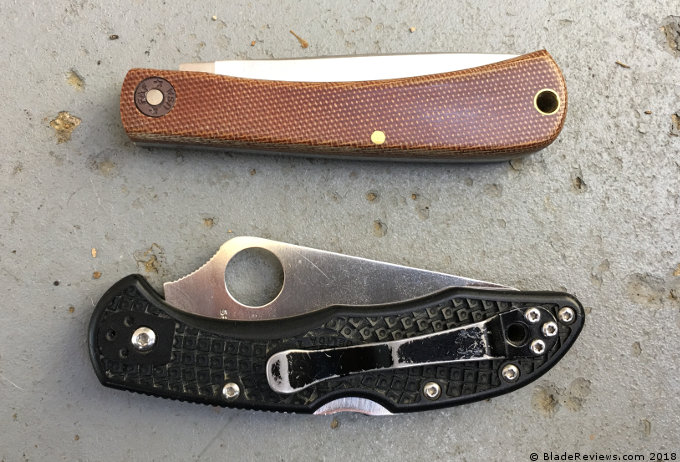
Well, I guess you can deploy the Bullnose either way without undue fuss. Pull is a stiffish 7, about perfect for a knife of this size and intent. I also appreciate the half stop. We’ve all had regular folding knives come down on our fingers when we close them negligently – but imagine the blade coming down with the force of a backspring behind it. Half stops are a safety feature that makes sense to me.
The strong backspring keeps the Bullnose’s blade open with surety, too. We associate the term ‘hard use’ irrevocably with locking knives, but the Bullnose feels like it could do rigorous chores without any danger of failure, as long as it’s used sensibly.
GEC #71 Bullnose Review – Final Thoughts
The Bullnose is without a doubt my favorite GEC knife. I don’t truck with multibladed traditionals, and while GEC makes quite a few single blade patterns, the Bullnose in particular enjoys a harmonious alchemy between size, utility, and (most importantly) affordability.
It checks all the GEC boxes – old school materials, delectable fit and finish, refined traditional patterns – without any specialized characteristics and extras, and it comes out in a large enough quantity that you can get one without having to queue up in a raffle or face a hardy gouging on the secondary market. You may end up getting more GECs after the Bullnose, but I don’t think you’ll ever find a better one.
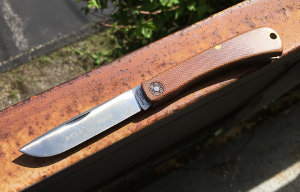
GEC #71 Bullnose
From: KnivesShipFree
Editor: I recommend purchasing the GEC 71 Bullnose at BHQ or KnivesShipFree. Please consider that buying anything through any of the links on this website helps support BladeReviews.com, and keeps the site going. As always, any and all support is greatly appreciated. Thank you very much.
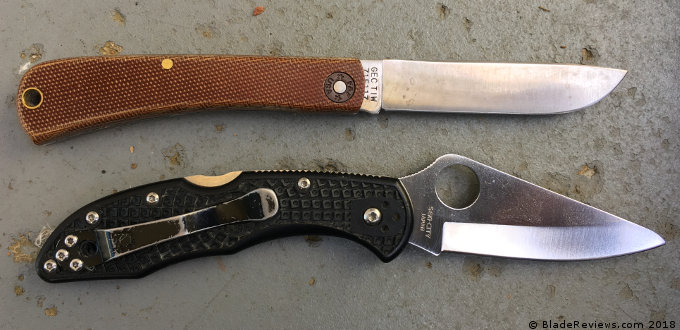
The Bullnose is one of my favorite knives. I do find the 1095 steel easy to maintain. Usually a few strokes on a strop is all that is needed. If the edge needs more attention a quick on session on my Spyderco Sharpmaker does the trick. Wiping the blade after use and keeping it dry will prevent most rust issues. I always lightly oil the blade if it is to be stored for any length of time. I often use the Bullnose for slicing an apple which really helps form a nice patina. I enjoyed your review and do reccomend this knife to anyone wanting to foray into the world of slipjoints.
Hey Mike,
Glad you enjoyed the review, thanks for reading. Yup, the 1095 must be a ‘me’ thing, most everyone I’ve spoken to about GEC says they have no problem with the steel. No idea why I find it so difficult.
Oiling a blade is always recommended, but I will say that once my Bullnose got its patina, I haven’t oiled it religiously even during extended periods of storage, and I haven’t had any rust issues. But of course safe is always better than sorry so I would suggest people take your route, not mine, and practice proper knife maintenance.
Ben.
It’s really silly to say that it’s sad that they use natural materials. They only use ethically sourced materials.